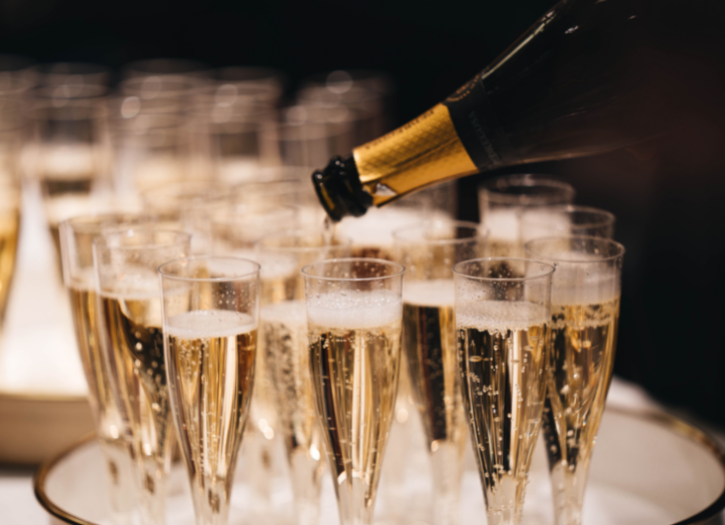Champagne is a sparkling wine.
Prestige Cuvée
A cuvée de prestige is a proprietary blended wine (usually a Champagne) that is considered to be at the top of a producer’s range. Famous examples include Louis Roederer‘s Cristal, Laurent-Perrier‘s Grand Siècle, Moët & Chandon‘s Dom Pérignon, Duval-Leroy‘s Cuvée Femme, Armand de Brignac Gold Brut, and Pol Roger‘s Cuvée Sir Winston Churchill.
Blanc de Noirs
A French term (literally “white from blacks” or “white of blacks”) for a white wine produced entirely from black grapes. The flesh of grapes described as black or red is white; grape juice obtained after minimal possible contact with the skins produces essentially white wine, with a slightly yellower color than wine from white grapes. The color, due to the small number of red skin pigments present, is often described as white-yellow, white-grey, or silvery.
Blanc de Blancs
A French term that means “white from whites”, and is used to designate Champagnes made exclusively from Chardonnay grapes or in rare occasions from Pinot blanc (such as La Bolorée from Cedric Bouchard). The term is occasionally used in other sparkling wine-producing regions, usually to denote Chardonnay-only wines rather than any sparkling wine made from other white grape varieties.
Rosé Champagne
Rosé Champagnes are characterized by their distinctive blush color, fruity aroma, and earthy flavor. Rosé Champagne has been produced since the late 18th century; storied French Champagne houses Rinault and Veuve Clicquot have each claimed to have shipped and sold the first bottles. The wine is produced by one of two methods. Using the saignée method, winemakers will leave the clear juice of dark grapes to macerate with the skins for a brief time, resulting in wine lightly colored and flavored by the skins. In the more common d’assemblage method, producers will blend a small amount of still red wine into a sparkling wine cuvée. Champagne is light in color even when it is produced with red grapes because the juice is extracted from the grapes using a gentle process that minimizes contact with the skins.
Sweetness
Just after disgorgement a “liqueur de dosage” or liqueur d’expédition – a blend of, typically, cane sugar and wine (sugar amounts up to 750 g/litre) – is added to adjust the levels of sugar in the Champagne when bottled for sale, and hence the sweetness of the finished wine. Today sweetness is generally not looked for per se, dosage is used to fine-tune the perception of acidity in the wine. For Caroline Latrive, cellar master of Ayala, a Champagne house that pioneered drier champagnes at the end of the 19th century, dosage represents the final touch in champagne making and must be as subtle as possible to bring the right balance.
The most common style today is Brut. However, throughout the 19th century and into the early 20th century Champagne was generally much sweeter than it is today. Moreover, except in Britain, Champagne was drunk as dessert wine.








Add Comment